TAGGED AS: Amazon, Comic Book, Prime Video, streaming, television, TV
Four paper girls on bikes, Halloween 1988, time travel, and purple skies – the imagery is evocative and very much at the center of Amazon’s adaptation of Paper Girls, premiering Friday. The comic book was a sensation upon release with its mixture of out-there sci-fi and coming-of-age drama. According to co-creator (and executive producer on the television show) Brian K. Vaughan, the story had its origins in his recollection of actual paper girls in the suburbs of Cleveland.
“There was just one day where all of our paper boys were suddenly replaced by these badass young women going out at four o’clock in the morning to deliver bad news,” he explained. “I was never a paper boy. I was just a shut-in nerd and just looking out at those cool, entrepreneurs … [they were] just adventurers.”
Initially meant to be supporting characters in another tale, he and co-creator Cliff Chiang soon realized the girls were the main characters.
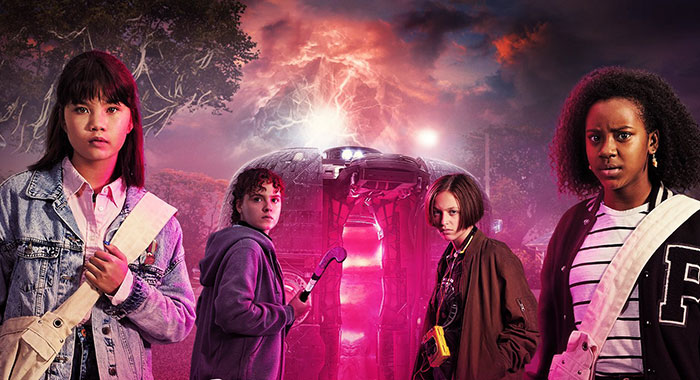
(Photo by Prime Video)
The group consists of (pictured above left to right) Erin Tieng (Riley Lai Nelet), KJ Brandman (Fina Strazza), Mac Coyle (Sofia Rosinsky), and Tiffany Quilkin (Camryn Jones). They are not friends when we first meet them; in fact, the morning of November 1, 1988, is Erin’s first day on the paper route and the others respond to her with various levels of hostility. But they are soon thrown together — first to protect one another from people still engaged in Halloween pranks and then against a time war brewing in their Stony Stream, Ohio, suburb.
The nature of the time war is one of the most obvious places where the television series diverts from the book. Some of the larger, visual shocks Chiang drew — like a giant tardigrade only time travelers could see — have been postponed in favor of stronger emotional hooks as the girls navigate their first time jump to the 21st century. According to executive producer Christopher C. Rogers, it was very much a conscious decision to lean into the emotions.
“We come from Halt and Catch Fire and other shows that are character-forward drama,” he explained. “And to bring that level of thoughtfulness to these four young protagonists was really our goal.”
The aim was to create a deeper understanding about the girls while also taking them seriously. Or, as Rogers put it, “Not play them as kids, but to play them at the height of our adult intelligence in a way that I think is really how it is to be 12.
“We felt like if we didn’t get that right, then the rest of it almost didn’t matter,” he continued. “[The show] is a high adventure that’s fantastic and it’s a thrill ride, but if you don’t care about the characters and if you can’t put yourself into their journey, then at a certain point, it’s spectacle. That mattered to us first, last, and always.”
Vaughn added, “Casablanca is my favorite war movie. That’s a war movie where you never see a tank battle or planes dropping bombs; it is characters in the forefront. That is what I love about television. It’s just getting to go in deep with characters.”

(Photo by Anjali Pinto/Prime Video)
Which isn’t to say there aren’t visual shocks with sci-fi elements leaking into the proceedings and occasionally taking the driver’s seat. But one of the key fantastic concepts the comic book and TV show share is the opportunity for the kids to meet themselves in the future.
“I wonder if that’s what’s universal about Paper Girls — we can all, in some ways, relate to this idea of what would it be like to encounter yourself from a different age?,” Rogers pondered. “Would you feel a disappointment? Would you look down on them? Would you be happy with how things turned out? I think to the extent we can disappear into these characters ourselves and they can touch emotions that we ourselves feel is the success of this show.”
Vaughan was quick to note that the idea actually emerged from Chiang.
“Cliff is very much the co-author. When I came to him with this idea — we’re going to have these four twelve-year-old protagonists. They’re going to go to prehistoric times. They’re going to go to the far future — right away he said, ‘Well, they’re also going to meet themselves, right? What if they’re meeting their 40-year-old self?’ … In the moment he said that I was like, ‘Oh, of course, that is what this story is about.’ So I love that the TV show took sort of Cliff’s initial idea and really ran to it far beyond what we did. Some very cool, unexpected kids meeting older versions of themselves.”
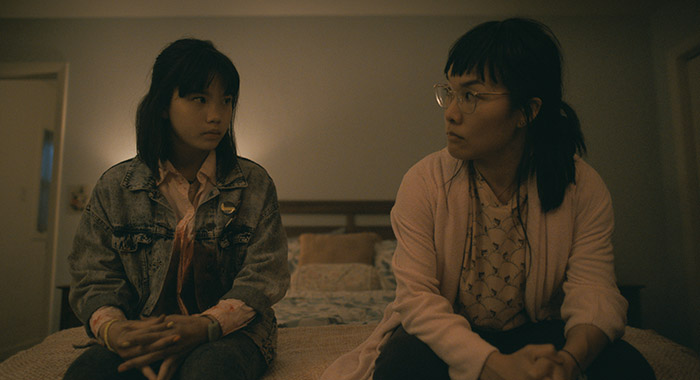
(Photo by Prime Video)
As seen in trailers for the program, Erin will meet her future self (played by Ali Wong) in a time period fairly contemporaneous to our own. And as also glimpsed in the trailers, it will be a shock for both.
“Erin has this perception of adults that they always have it figured out and adults always know what they’re doing,” Nelet explained. “And so when she meets her older self, she’s kind of slapped in the face with reality.”
The other girls will also get some glimpses into their futures as the season wears on, but, Rogers added, “It’s not like each episode we meet an older self.” Instead, that aspect of the premise will underscore the growing friendships between the characters.
Asked if they would be willing to meet their future selves, only Jones said she was ready to do so.
“Older me would recognize younger me, though,” Jones said, “so I’d dress up as like a grandma and put on prosthetics and everything and go to Party City and get a wig or something. And then I’d go and I’d ask questions just to like see where I am in life, because I think that’d be cool. Plus, it wouldn’t affect anything up to that point. So, I’d be fine. I’d go talk to me.”
As Rogers said, the characters anchor the series and the group of young talent assembled do an admirable job in that mission. Some, like Strazza and Nelet, seem as though they stepped right off the page while Jones and Rosinsky add unexpected, but welcome dimensions to their characters — and aspect of the adaptation that left Chiang feeling like “we did communicate something in the comic.”
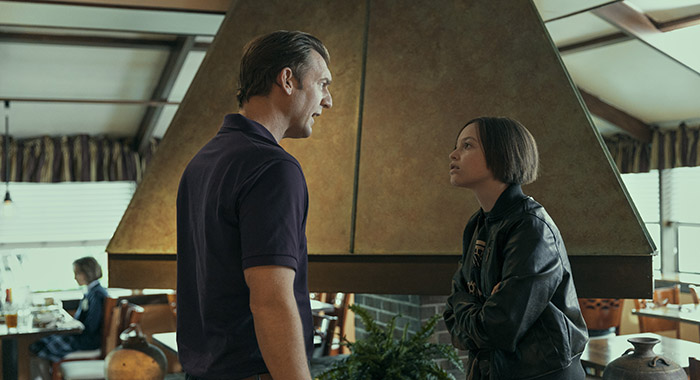
(Photo by Anjali Pinto/Prime Video)
Rosinksy’s Mac, for example, comes off a little more abrasive than her comic book counterpart, a detail she credits to the translation from panel to performance.
“I brought my own interpretation, my own twist on it … She is quite abrasive in the show, but Mac is obviously very guarded. I hope that people will stick with her long enough to see her journey,” she said.
Nelet also felt a balance needed to be struck in building the characters out from the page while remaining faithful to the core traits laid out by Vaughan and Chiang.
“I think it was a little bit of both,” she said. “I think we definitely embody the characters very well, but also bringing a specific new essence to them on screen, which I think is really phenomenal.”
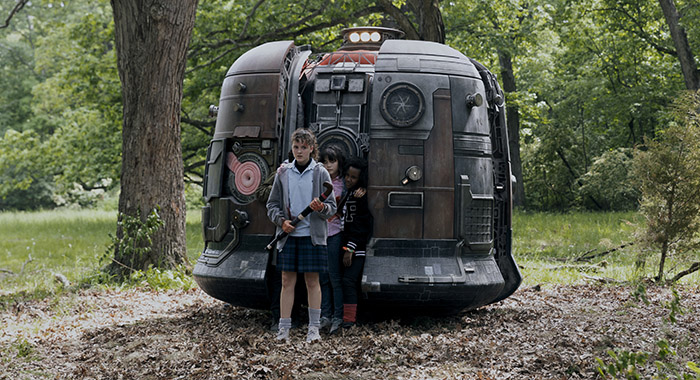
(Photo by Anjali Pinto/Prime Video)
Jones added their prep work included writing notebooks to get a feel for the characters likes and dislikes. The results will likely please fans of the comic as they discover, for example, a Tiffany more outwardly enthusiastic about science and the girl’s sci-fi predicament while KJ’s discovery about herself takes on a different form than the comic book.
“It’s great that each of the girls have sort of a unique experience with seeing how their life turns out,” Strazza said. “[KJ] just wanted a little taste of it to help with what she was going through … not necessarily what she becomes, but more to find out who she is when she’s 12 years old and just help her find herself in that moment.”
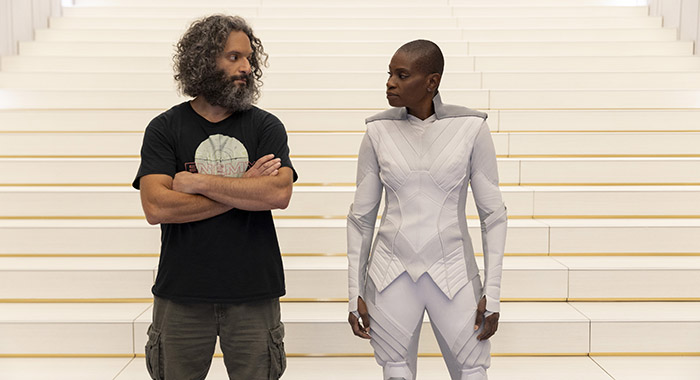
(Photo by Anjali Pinto/Prime Video)
All the bonding and self-discovery via time travel does come with a threat, though, represented by Adina Porter’s Prioress. A chameleon of sorts, she is after the girls for reasons which will become clear. But she also initially appears as an implacable force of nature in her attempts to attain her goal. “She’s a warrior, she’s a fighter, and she believes in her mission … I have a history of playing people who some people hate, but I always like to bring in the humanity. And so if you hate me, there has to be a reason,” Porter said of the character.
That reason may revolve around Jason Mantzoukas’ Grandfather, a being from the future who seemingly has the clearest understanding of time and why, suddenly, these four paper girls are a key front of the time war.
“The stakes couldn’t be higher [for Grandfather and the Prioress],” he said. “It’s not just that we are parents to a group of misbehaving children who are scolding them. The stakes are the end of everything, the end of time itself.”
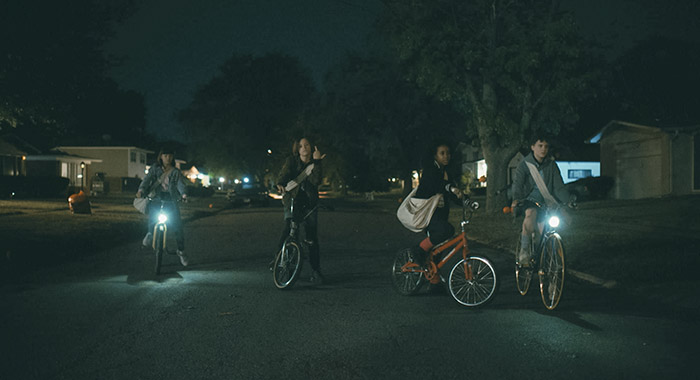
(Photo by Prime Video)
But considering this is a time-travel show, were the girls always destined to be at the center of the conflict?
“I think that it may have started out as sort of a mess up, but I think that it was meant to happen though,” Rosinksy said. “Somewhere in there, it happened for a reason.”
Mantzoukas agreed it was likely an accident, but “it’s an accident that can’t be undone really.”
Porter added, “In life, you go, ‘There are no accidents.'”
And just as there are no accidents, there are things fans of the comic book may not see in season 1 that may still end up in the second season. When asked about some of those elements and storylines, Rogers offered an enigmatic “stay tuned.”
![]() 87%
Paper Girls: Season 1
(2022)
debuts on July 29 on Prime Video.
87%
Paper Girls: Season 1
(2022)
debuts on July 29 on Prime Video.